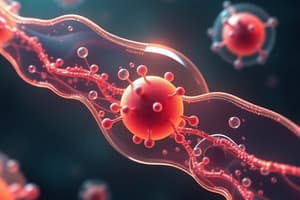Podcast
Questions and Answers
Which of the following is the main function of the cell's plasma membrane?
Which of the following is the main function of the cell's plasma membrane?
- To retain necessary substances inside the cell (correct)
- To provide structure to the cell
- To protect the cell from the outside environment
- To excrete waste material outside the cell
What is the composition of the cell's plasma membrane?
What is the composition of the cell's plasma membrane?
- Proteins and carbohydrates
- Carbohydrates and lipids
- Phospholipids and proteins (correct)
- Nucleic acids and lipids
How are phospholipids arranged in the cell's plasma membrane?
How are phospholipids arranged in the cell's plasma membrane?
- In three layers
- In a single layer
- In a lipid bilayer (correct)
- In a lipid trilayer
What is the function of the embedded proteins in the cell's plasma membrane?
What is the function of the embedded proteins in the cell's plasma membrane?
Which type of substances can easily pass through the cell's plasma membrane?
Which type of substances can easily pass through the cell's plasma membrane?
Which type of substances can easily pass through the cell's plasma membrane?
Which type of substances can easily pass through the cell's plasma membrane?
What is the main function of the cell's plasma membrane?
What is the main function of the cell's plasma membrane?
How are phospholipids arranged in the cell's plasma membrane?
How are phospholipids arranged in the cell's plasma membrane?
What is the composition of the cell's plasma membrane?
What is the composition of the cell's plasma membrane?
What is the function of the embedded proteins in the cell's plasma membrane?
What is the function of the embedded proteins in the cell's plasma membrane?
Flashcards are hidden until you start studying
Study Notes
Cell Membrane Function
- The cell's plasma membrane acts as a barrier that selectively controls what enters and exits the cell.
Cell Membrane Composition
- The cell membrane is composed primarily of a phospholipid bilayer.
- The bilayer consists of two layers of phospholipids, with their hydrophilic (water-loving) heads facing the outside and inside of the cell, and their hydrophobic (water-fearing) tails facing each other in the middle.
Phospholipid Arrangement
- The phospholipids in the cell membrane are arranged in a bilayer structure.
- The hydrophilic heads of the phospholipids face the watery environment both inside and outside the cell.
- The hydrophobic tails of the phospholipids face each other in the middle of the membrane.
Embedded Proteins
- Proteins are embedded within the phospholipid bilayer.
- These proteins have various functions, including transporting molecules across the membrane, acting as receptors for signaling molecules, and providing structural support.
Permeability
- Small, nonpolar molecules (like oxygen and carbon dioxide) can easily pass through the cell membrane.
- Larger, polar molecules (like glucose and ions) need help from transport proteins to cross the membrane.
Studying That Suits You
Use AI to generate personalized quizzes and flashcards to suit your learning preferences.




